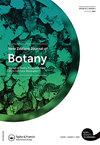Hymenotorrendiella clelandii (Leotiomycetes, Helotiales, Helotiaceae) and related species from Australia and New Zealand
IF 1.4
4区 生物学
Q4 PLANT SCIENCES
引用次数: 1
Abstract
ABSTRACT Fungi in the class Leotiomycetes are ecologically diverse, including mycorrhizas, endophytes of roots and leaves, plant pathogens, aquatic and aero-aquatic hyphomycetes, mammalian pathogens, and saprobes. Hymenotorrendiella species are often assumed to be saprobic, their fruiting bodies developing on fallen leaves and dead wood but, in many cases, these putative saprobes are found on only a single host. For the leaf-inhabiting species this host specialisation has been shown to be driven by an endophytic phase to the life cycle, the initial infection of the host being on living leaves. Host specialisation has resulted in high levels of species diversity but within Hymenotorrendiella most of these species remain unnamed. In this paper four species of Hymenotorrendiella are accepted from Eucalyptus in Australia — the leaf-inhabiting H. communis, as well as three wood-inhabiting species, H. clelandii, and two species described here as new, H. spooneri and H. brevis. The leaf-inhabiting H. communis has an endophytic phase to its life cycle, fruiting on dead leaves but with infection initiated while the leaves are still alive and appears to have been moved around the world along with its Eucalyptus host. The biology of the wood-inhabiting species is unknown although H. clelandii occurs also in New Zealand on introduced Eucalyptus. Also described here are two other wood-inhabiting species from New Zealand that are closely related to H. clelandii – H. coriariae from Coriaria arborea, and H. pruinosa from Leptospermum and Kunzea. H. spooneri as accepted here appears to comprise a phylogenetically diverse complex of several closely related sister populations. These populations differ somewhat morphologically, but each is represented by only one specimen, making it impossible at present to assess the possible taxonomic significance of those morphological differences.澳洲及纽西兰的clelandii(绒膜菌属,绒膜菌属,绒膜菌科)及其近缘种
摘要Leotiomycetes类真菌在生态上是多样的,包括菌根、根和叶的内生菌、植物病原体、水生和气动水生菌丝体、哺乳动物病原体和皂化物。Hymenotorendiella物种通常被认为是腐生物,它们的子实体在落叶和枯木上发育,但在许多情况下,这些假定的腐生物只在单个宿主上发现。对于栖息在叶子上的物种,这种宿主的特化已被证明是由生命周期的内生阶段驱动的,宿主的最初感染是在活叶子上。寄主专业化导致了高水平的物种多样性,但在膜壳虫中,大多数物种仍未命名。在本文中,从澳大利亚的桉树中发现了四种Hymenotorendiella,即栖息在树叶中的H.commons,以及三种栖息在木材中的H.clelandii,以及两种新物种H.spooneri和H.brevis。栖息在共产主义者身上的叶子在其生命周期中有一个内生阶段,在枯叶上结果实,但在叶子还活着的时候就开始感染,并且似乎与桉树宿主一起在世界各地移动。木材栖息物种的生物学尚不清楚,尽管H.clelandii也出现在新西兰引进的桉树上。这里还描述了另外两个来自新西兰的栖息在木材上的物种,它们与H.clelandii有密切的亲缘关系——来自树Coraria的H.corariae,以及来自Leptispermum和Kunzea的H.pruinosa。这里所接受的H.spooneri似乎包括几个亲缘关系密切的姐妹种群的系统发育多样性复合体。这些种群在形态上有所不同,但每个种群只有一个标本,因此目前无法评估这些形态差异的可能分类学意义。
本文章由计算机程序翻译,如有差异,请以英文原文为准。
求助全文
约1分钟内获得全文
求助全文
来源期刊

New Zealand Journal of Botany
生物-植物科学
CiteScore
2.20
自引率
22.20%
发文量
27
审稿时长
>12 weeks
期刊介绍:
The New Zealand Journal of Botany publishes original research papers, review papers, perspectives, short communications, forum articles, letter and book reviews. We welcome submissions relevant to all aspects of the botany, mycology, and phycology of the South Pacific, Australia, South America, and Southern Africa. The journal’s subject matter encompasses biosystematics and biogeography, ecology, physiology, biochemistry, genetics, reproductive biology, structure and development, taxonomy, ethnobotany, palaeobotany, bryology, lichenology, mycology, plant pathology, and phycology.
 求助内容:
求助内容: 应助结果提醒方式:
应助结果提醒方式:


